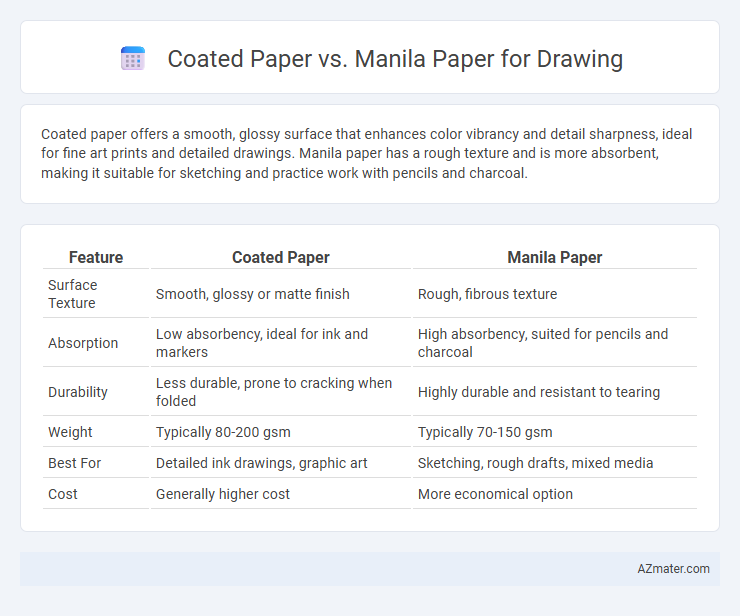Coated paper offers a smooth, glossy surface that enhances color vibrancy and detail sharpness, ideal for fine art prints and detailed drawings. Manila paper has a rough texture and is more absorbent, making it suitable for sketching and practice work with pencils and charcoal.
Table of Comparison
| Feature | Coated Paper | Manila Paper |
|---|---|---|
| Surface Texture | Smooth, glossy or matte finish | Rough, fibrous texture |
| Absorption | Low absorbency, ideal for ink and markers | High absorbency, suited for pencils and charcoal |
| Durability | Less durable, prone to cracking when folded | Highly durable and resistant to tearing |
| Weight | Typically 80-200 gsm | Typically 70-150 gsm |
| Best For | Detailed ink drawings, graphic art | Sketching, rough drafts, mixed media |
| Cost | Generally higher cost | More economical option |
Introduction to Drawing Papers
Drawing papers differ significantly between coated paper and Manila paper based on texture and absorbency, impacting artistic techniques and media compatibility. Coated paper features a smooth, sealed surface that enhances ink and marker vibrancy while minimizing bleed-through, ideal for detailed, precise artwork. Manila paper offers a rougher texture with high absorbency, suited for charcoal, pastel, and pencil, providing strong tooth for grip but less smoothness for fine lines.
What is Coated Paper?
Coated paper features a smooth surface achieved through a layer of coating materials like clay, chalk, or polymers, enhancing ink hold and color vibrancy, making it ideal for detailed drawings with paints or markers. Its finish reduces absorbency, allowing for sharper lines and more precise blending compared to the porous, rough texture of Manila paper, which is typically better suited for pencil or charcoal sketches. Artists selecting between coated and Manila paper should consider the medium used and desired visual effects, as coated paper excels in producing bright, crisp artwork with minimal bleeding.
What is Manila Paper?
Manila paper is a sturdy, slightly textured paper made from hemp or abaca fibers, often used for sketching, drafting, and drawing due to its durability and moderate absorbency. Unlike coated paper, which has a smooth, glossy finish ideal for ink and markers but less absorbent, Manila paper allows for better control of graphite, charcoal, and pastels, enhancing blending and shading techniques. Its natural, earthy tone provides a unique background that complements pencil and colored pencil artworks, making it a popular choice for artists seeking a tactile surface.
Surface Texture and Feel
Coated paper features a smooth, sealed surface that enhances ink absorption and produces sharper, more vibrant lines, making it ideal for detailed, fine art drawings. Manila paper has a rougher, fibrous texture that offers more tactile feedback and natural tooth, suitable for sketches and charcoal work where grip and texture are essential. Artists prefer coated paper for precision and color vibrancy, while manila paper is favored for expressive, textured effects.
Paper Weight and Thickness
Coated paper typically features a smoother surface with a weight range between 100 to 200 gsm, offering medium thickness ideal for detailed ink and marker drawings without excessive bleed-through. Manila paper, generally lighter with weights around 50 to 80 gsm and a thinner profile, is more porous and suited for rough sketches or practice due to its absorbent texture but less durability. The choice between coated and manila paper depends on the desired finish and medium compatibility, with coated paper providing greater stability and vibrant color retention for professional artwork.
Color Reproduction and Vibrancy
Coated paper enhances color reproduction and vibrancy by providing a smooth, non-absorbent surface that prevents inks and pigments from spreading, resulting in sharper and more vivid drawings. Manila paper, with its porous, fibrous texture, absorbs more ink and pigment, leading to muted colors and less intense vibrancy. For artists prioritizing bright, dynamic color output and fine detail, coated paper is the superior choice over Manila paper.
Suitability for Different Drawing Media
Coated paper features a smooth, sealed surface ideal for ink, markers, and digital prints, providing sharp lines and vibrant colors without excessive bleeding. Manila paper, with its rough texture and porous quality, excels for charcoal, pastel, and pencil sketches, allowing for better blending and layering of dry media. Artists selecting drawing surfaces should match media types with paper characteristics to optimize texture, absorbency, and final artwork appearance.
Durability and Longevity
Coated paper offers enhanced durability and longevity for drawing due to its smooth, sealed surface that resists moisture, smudging, and wear over time, making it ideal for archival-quality artwork. Manila paper, while flexible and cost-effective, lacks a protective coating, resulting in quicker degradation, increased susceptibility to tearing, and diminished resistance to environmental factors. Artists seeking long-lasting, vibrant drawings favor coated paper to ensure preservation and sustained visual integrity.
Cost Comparison
Coated paper generally costs more than Manila paper due to its specialized surface that enhances print quality and color vibrancy, making it ideal for detailed drawing and artwork. Manila paper is significantly cheaper and widely used for sketching and rough drafts but lacks the smooth finish required for high-quality drawings. Artists seeking a budget-friendly option may prefer Manila paper, while those prioritizing professional presentation often invest in coated paper despite the higher price.
Choosing the Right Paper for Your Artwork
Choosing the right paper for artwork depends on the desired texture and medium durability, with coated paper offering a smooth surface ideal for detailed ink and marker work, while Manila paper provides a rougher texture suitable for charcoal and pastel applications. Coated paper's non-porous finish allows colors to appear more vibrant and prevents ink bleed, making it perfect for digital printing and fine line illustrations. In contrast, Manila paper's absorbent fibers hold graphite and charcoal well, enhancing shading effects and blending techniques important for traditional drawings.

Infographic: Coated paper vs Manila paper for Drawing
 azmater.com
azmater.com